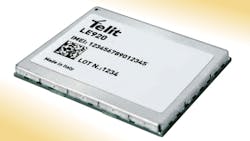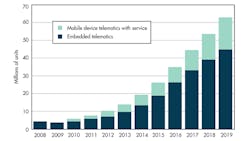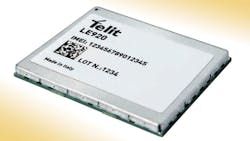This file type includes high resolution graphics and schematics.
If you’re familiar with OnStar, which General Motors has offered for nearly two decades, you have a sense of what telematics is all about. It connects your automobile to helpful emergency and driver services, usually via the cellular network. Yet telematics is just one part of the expanding inclusion of electronic systems and communications in vehicles (Fig. 1).
Today’s automotive electronics include multimedia entertainment, vehicle status monitoring, and a huge range of new safety and security features. Also forthcoming are automated vehicle-to-vehicle or vehicle-to-infrastructure wireless communication systems that are expected to provide even more safety and convenience (see “New Technologies In The Vehicle”).
Defining Telematics
Telematics uses wireless technologies to connect the driver and passengers to external sources of information, entertainment, and other services. Connectivity is achieved via the standard cellular networks, although both Wi-Fi and Bluetooth are used extensively for internal vehicle communications and for some outside hotspots.
There are two flavors of telematics: embedded and non-embedded. The embedded format, sometimes called OEM telematics, is implemented with a built in cell-phone system (Fig. 2). Embedded OEM systems are usually accompanied by monthly monitoring service for a fee. Non-embedded or “tethered” systems use a cell phone plugged into the vehicle systems.
GM’s OnStar system is the best example of an embedded system. Ford’s Sync, a non-embedded system, uses the driver’s smart phone to connect to external sources. Each car or truck manufacturer has a unique system using one approach or the other. In both cases, a voice-active hands-free component makes it easy for drivers to use the services offered.
Then, there are aftermarket units—which may or may not have an embedded smart phone—that can be added to any vehicle. The automotive aftermarket is concerned that embedded telematics devices are creating closed ecosystems and shutting it out. The aftermarket is worth an estimated $1.8 trillion annually.
There are two major segments in automotive telematics: safety and security, and infotainment. Safety and security services vary widely from system to system. Complete embedded systems like GM’s OnStar and BMW’s ConnectedDrive offer automatic collision detection, remote door unlocking, light and horn activation, and stolen vehicle recovery or slowdown.
Related Articles
• Line Between Telematics And Infotainment Blurs Even Further
• Expanding Telematics For The Masses
• Losing Your Car Keys Won’t Matter With Your NFC-Enabled Mobile Phone
Full-service systems may include turn-by-turn navigation, roadside assistance notification, 24/7 emergency response, and general advisory service. Non-embedded systems aren’t that far along in external services, but that’s expected to change as more vehicles include more complete telematics services.
Infotainment covers four major areas: navigation, multimedia, social media, and in-vehicle Wi-Fi. Navigation includes embedded maps with turn-by-turn direction, real-time traffic information, parking availability, and local search (see “The Internet Of Things Hits The Road”).
The multimedia segment includes built-in entertainment systems with AM/FM/HD/satellite radio, the CD player, and connection to music files on the smart phone. It also includes multimedia streaming of music or video. Many auto manufacturers are beginning to provide Internet radio like Pandora as well.
The social media segment makes it possible to connect to popular sites like Facebook and Twitter from the road. Voice recognition and response are the only methods to make these applications viable and safe, though.
Finally, each vehicle is a Wi-Fi hotspot that can connect passengers to the Internet via the cellular network. From four to eight passengers can access the Internet with their laptops, tablets, and smart phones during a trip.
Telematics systems also include a large color touchscreen display that drivers can use to access their various features. GPS navigation typically uses the screen. Many newer vehicles also feature video backup cameras that use the same screen. A graphical user interface provided by an internal operating system lets drivers select applications with icons. Inside the vehicle, Bluetooth is used in the hands-free voice activation system and for music connections.
Current Status Of Telematics
While telematics systems have been available for years, they have not been widespread. Of the tens of millions of GM cars sold over the years, there are only about 6 million current OnStar subscribers. But that is changing rapidly. To be competitive today, most car manufacturers must include telematics as standard or an option.
Most telematics systems were available only in high-end or luxury models. Today, they’re offered either as a standard feature on some models or as an option on all models including lower-priced vehicles. ABI Research predicts that over 90% of all new vehicles will offer telematics by 2016.
All of the U.S. manufacturers offer telematics. OnStar is the clear leader worldwide. GM continues to offer OnStar on all models including its lowest priced. Ford and Lincoln have had telematics off and on since 1996 but have not been as successful as GM. In 2007, however, Ford introduced its Sync system in Lincoln and high-end Ford models.
Sync has been well received, and Ford now includes it on some lower-priced models as an option. It uses the driver’s smart phone for connectivity. The system uses a Microsoft operating system and user interface. The rollout to all models is expected over the coming years. Ford is also adding OnStar-like services that can match up with the driver’s phone features and capabilities.
In 2012, Chrysler introduced its UConnect Access telematics system and services. It is offered mainly on Viper and Ram trucks as well as some upscale Chrysler 300 models. More models will have access to it in the coming years. The Chrysler system is embedded and uses the Sprint network for connectivity. It is also becoming available on Fiat, Maserati, Ferrari, Alfa Romeo, and Lancia models that are part of the Fiat family.
Most non-U.S. manufacturers now offer some form of telematics on selected models. BMW has offered its ConnectedDrive safety and security system since 1999. Its newer Assist embedded system uses AT&T connectivity. It offers a range of services like OnStar with remote door unlocking, stolen vehicle tracking, and navigation.
Mercedes-Benz offers a similar system called Embrace with a service named Tele Aid. It offers services similar to the BMW and GM systems. The telematics is an option on the high-end models but is gradually finding its way into less pricy models. An Embrace 2 version is now available with advanced features.
Audi’s system, Audi Connect, is available on high-end models but is gradually migrating to all models. It uses T-Mobile wireless services. Volkswagen has telematics as well in the form of Hughes Telematics. It is a comprehensive suite of features and services for safety and security, convenience, and diagnostics.
Hyundai offers the Blue Link system, and Kia has the UVO system. Toyota has the Safety Connect system, and Lexus has the Enform system. Honda now has the HondaLink system, while its upscale Acura models have the AcuraLine system. Nissan and Infiniti lag in telematics, but the Nissan Leaf all-electric vehicle has some telematics functionality. Infiniti’s Connection system option is being expanded to include Nissan models.
Development Considerations
As you’re designing telematics products or systems, there are several important considerations to keep in mind:
• Driving distractions: This is most critical issue in all systems (see “Denying Driver Distraction”).
As more electronics are added to the car, the possible number of distractions increases. Some of the main goals of telematics are safety related, yet new features involving more functions or greater data input simply result in more diversions of attention.
• Minimal standards: There are few if any standards except for the use of known cellular, Wi-Fi, and Bluetooth. The Dedicated Short Range Communication (DSRC) 802.11p standard will also be used. The 4G LTE standard will be a necessity in the future to handle the massive data flow to and from vehicles.
• Cost and complexity: Telematics greatly increases vehicle cost and complexity. The new electronics add more wiring, power consumption, and user interfaces. Initial costs must be weighed against marketing benefits and perceived user value and function. The time and cost of repairs and service later in the vehicle life also should be factored in.
This file type includes high resolution graphics and schematics.
• More powerful computing: Designers are working to reduce the number of individual embedded controllers in cars from the 10 to 100 now used to fewer processors that are more powerful with a real-time operating system (RTOS) to manage and control all the various electronic systems. Such systems will permit more software applications to be developed and provide a platform that can employ artificial intelligence software for data analysis and decision-making. For example, Texas Instruments’ Jacinto 6 or DRA74x family of OMAP multicore processors targets graphical human-machine interfaces (HMIs), navigation, analog and digital radio, backseat entertainment, and multimedia playback.
• Service transfer: How do you transfer equipment and services in a vehicle to another buyer? When the owner sells or trades in a vehicle, how are the electronics and any related services handled? Car manufacturers and service providers must address these issues.
• Mandates: Since the government is involved in telematics and related services, watch for mandates specified by new rules and regulations.
• Business model: What is the plan to profit? Automobile manufacturers will benefit from equipment sales as well as some services. Cellular providers and third-party vendors will profit from wireless services. Other players will find a way to make money. Governments will be involved in the Intelligent Transportation System (ITS) efforts and may collect fees or raise taxes in some form to pay for any infrastructure costs.
The Intelligent Transportation System
The ITS is a program of the U.S. Department of Transportation’s (DOT’s) Research and Innovative Technology Administration (RITA). It is the DOT’s vision of how to improve surface transportation safety and mobility through the use of innovative information and communication technology. Components include automatic toll collection, GPS navigation systems, automatic braking, collision avoidance systems, and digital signs.
RITA’s job is to develop and test new systems and publish standards and recommendations for implementation. If proven valuable, some of these systems will become mandates of the National Highway Traffic Safety Administration (NHTSA). A wide range of new infrastructure and in-vehicle systems is in the works.
A similar ITS effort is going on in Europe, including not only automotive applications but also buses, trucks, trains, marine craft, and aircraft. In addition to the 802.11p DSRC wireless local-area network (WLAN) connectivity, some intelligent transport systems will feature satellite and terrestrial broadcast stations.
One of the most interesting research initiatives is V2x, or vehicle-to-vehicle (V2V) and vehicle-to-infrastructure (V2I) systems. These systems use a DSRC wireless system that is similar to the 802.11a Wi-Fi standard. Designated 802.11p, it uses the unlicensed 5.9-GHz band for V2V and V2I links to roads and other infrastructure. Again, the overall goals are to improve safety and keep traffic flowing.
Other research programs include real-time data capture and management, road weather management, and human factors. Real-time data capture collects data from on-the-road vehicles and attempts to assess traffic and road conditions to make transportation more efficient. Road weather collects weather and road conditions data from vehicles and existing infrastructure to provide drivers current conditions and advanced warnings. Human factors research will attempt to determine when drivers are overwhelmed with data and the degree of distraction that leads to unsafe conditions.
Wireless Standards
The DSRC system for V2V and V2I is based on the IEEE 802.11p standard and a protocol known as Wireless Access in Vehicular Environments (WAVE). The DSRC is assigned a 75-MHz segment of spectrum from 5.85 to 5.925 GHz. There are seven 10-MHz channels designated by even numbers from 172 to 184. These channels are half the size of a standard 20-MHz 802.11 channel to minimize Doppler shift and multipath fading. Channel 178 is the control channel (CCH), and the others are service channels (SCH). A European version of the system is assigned 50 MHz of bandwidth for five channels.
The spectrum will allow vehicle and roadside unit (RSU) infrastructure radios to form vehicular ad hoc networks (VANETs). These networks will be dynamic and provide short-lived intermittent connectivity to implement various safety applications for collision avoidance and road safety. Connections are automatic. The 802.11p standard radio is half duplex with a date rate in the 6- to 27-Mbit/s range and has an estimated maximum range of 300 meters.
The WAVE protocol uses the standard physical layer (PHY) and media access control (MAC) layer of the 802.11a standard but uses the IEEE 1609 standard family for the upper layers including a MAC extension, a logical link control (LLC) layer, network and transport layers that include IPv6 with user datagram protocol (UDP) and transmission control protocol (TCP), and an upper message application layer. The 1609.2 standard provides security. Several different types of short message formats have been developed for different conditions.
Inside the car, passengers can use a standard 802.11a/b/g/n Wi-Fi hotspot for connecting laptops and tablets to the car cellular radio for Internet access. Some video connections and links to dealer diagnostic networks will be Wi-Fi. Bluetooth is also used for hands-free voice and music transfer connections. LTE is the cellular wireless technology of choice for all future systems.
On The Road
The connected car is a work in progress in various stages of development. While some of these ideas have been around for years, the cell phone and other wireless technologies are bringing them to fruition. The connected car also is just one part of the blossoming machine-to-machine (M2M) movement. In-vehicle offerings are meager now but are growing quickly. V2V and V2I systems are still under development and some are in trials around the country, but they won’t be fully deployed for years.
Also, automotive development and life cycles are significantly longer than they are for electronic equipment. Auto systems take at least three years or more to develop, followed by a profitable three-year life cycle and then a three-year or more declining life period. Telematics will probably follow that pattern. Nevertheless, you can begin to enjoy connected car features and services today with many new vehicles. The next big development will be the driverless car.
This file type includes high resolution graphics and schematics.
About the Author

Lou Frenzel
Technical Contributing Editor
Lou Frenzel is a Contributing Technology Editor for Electronic Design Magazine where he writes articles and the blog Communique and other online material on the wireless, networking, and communications sectors. Lou interviews executives and engineers, attends conferences, and researches multiple areas. Lou has been writing in some capacity for ED since 2000.
Lou has 25+ years experience in the electronics industry as an engineer and manager. He has held VP level positions with Heathkit, McGraw Hill, and has 9 years of college teaching experience. Lou holds a bachelor’s degree from the University of Houston and a master’s degree from the University of Maryland. He is author of 28 books on computer and electronic subjects and lives in Bulverde, TX with his wife Joan. His website is www.loufrenzel.com.



